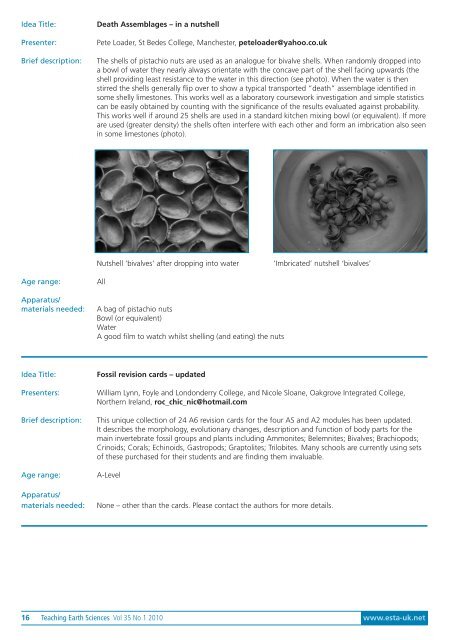Teaching Earth Sciences - Earth Science Teachers' Association
Teaching Earth Sciences - Earth Science Teachers' Association
Teaching Earth Sciences - Earth Science Teachers' Association
You also want an ePaper? Increase the reach of your titles
YUMPU automatically turns print PDFs into web optimized ePapers that Google loves.
Idea Title:<br />
Presenter:<br />
Brief description:<br />
Death Assemblages – in a nutshell<br />
Pete Loader, St Bedes College, Manchester, peteloader@yahoo.co.uk<br />
The shells of pistachio nuts are used as an analogue for bivalve shells. When randomly dropped into<br />
a bowl of water they nearly always orientate with the concave part of the shell facing upwards (the<br />
shell providing least resistance to the water in this direction (see photo). When the water is then<br />
stirred the shells generally flip over to show a typical transported “death” assemblage identified in<br />
some shelly limestones. This works well as a laboratory coursework investigation and simple statistics<br />
can be easily obtained by counting with the significance of the results evaluated against probability.<br />
This works well if around 25 shells are used in a standard kitchen mixing bowl (or equivalent). If more<br />
are used (greater density) the shells often interfere with each other and form an imbrication also seen<br />
in some limestones (photo).<br />
Nutshell ‘bivalves’ after dropping into water<br />
‘Imbricated’ nutshell ‘bivalves’<br />
Age range:<br />
Apparatus/<br />
materials needed:<br />
All<br />
A bag of pistachio nuts<br />
Bowl (or equivalent)<br />
Water<br />
A good film to watch whilst shelling (and eating) the nuts<br />
Idea Title:<br />
Presenters:<br />
Brief description:<br />
Age range:<br />
Apparatus/<br />
materials needed:<br />
Fossil revision cards – updated<br />
William Lynn, Foyle and Londonderry College, and Nicole Sloane, Oakgrove Integrated College,<br />
Northern Ireland, roc_chic_nic@hotmail.com<br />
This unique collection of 24 A6 revision cards for the four AS and A2 modules has been updated.<br />
It describes the morphology, evolutionary changes, description and function of body parts for the<br />
main invertebrate fossil groups and plants including Ammonites; Belemnites; Bivalves; Brachiopods;<br />
Crinoids; Corals; Echinoids, Gastropods; Graptolites; Trilobites. Many schools are currently using sets<br />
of these purchased for their students and are finding them invaluable.<br />
A-Level<br />
None – other than the cards. Please contact the authors for more details.<br />
16 <strong>Teaching</strong> <strong>Earth</strong> <strong><strong>Science</strong>s</strong> Vol 35 No 1 2010 www.esta-uk.net

















